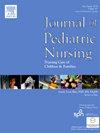Winning Poster: An evaluation of a novel pediatric transitional care facility for neonatal abstinence syndrome care
IF 2.3
4区 医学
Q2 NURSING
Journal of Pediatric Nursing-Nursing Care of Children & Families
Pub Date : 2025-09-01
DOI:10.1016/j.pedn.2025.06.039
引用次数: 0
Abstract
Rising rates of Opioid use during pregnancy are creating new challenges in treatment of perinatal women with substance use disorders and their infants experiencing substance withdrawal symptoms (Neonatal Abstinence Syndrome [NAS]). System-level challenges, including fragmented healthcare systems and limited access to comprehensive perinatal care highlight significant gaps in neonatal care amidst rising Opioid use. Pediatric transitional nurseries are a relatively recent development in the United States, designed to offer comprehensive care for infants exposed to substances in utero by emphasizing non-pharmacological interventions centered on the maternal-infant dyad. However, there is currently a lack of research that assesses the outcomes of infants utilizing these facilities. Objective: The aim of this study was to determine the health outcomes of infants with in-utero substance exposure utilizing services of a pediatric transitional care facility across an 18-month period in Washington state. Methods: The pediatric transitional care facility provided descriptive data for 71 infants and birthing parents utilizing its services between 2023 and 2024. The Hopkin's Tool (Velez et al., 2021) was used to assess the progress of the infants throughout their stay at the facility at three time points (Admit, Midpoint, and Most Recent/Discharge). This assessment monitors four systems (Autonomic Nervous System, Motor/Muscle Tone, State Control/Attention, Sensory Reactivity) via a three-category scale: Impaired; Mild Dysfunction; Optimal. A one-way analysis of variance (ANOVA) was used to assess potential change in each individual systems' mean Hopkin's Tool score over time and, when appropriate, a post-hoc Tukey test was used to identify significant changes. Infant demographic and medical data, as well as birthing parent data were also collected and are described using means, standard deviations, and percentages. Results: On average, infants were exposed to 3.7 different substances (standard deviation [SD]: 1.6) The most common substance exposure was to methamphetamines (n = 57; 81.4 %) followed by fentanyl (n = 52; 74.3 %), tobacco (n = 38; 53.5 %), methadone (n = 30; 42.3 %), marijuana (n = 22; 31.4 %), and other unspecified opioids (n = 17; 24.3 %). Sixty infants that had been discharged back into the community had data on their length of stay at Maddie's Place. The average length of stay of those infants that had been discharged was 56 days (SD: 31.9). Information on birthing parents was provided for 63 infants. The largest group, 34 infants (54 %), went into the community with their birthing parent, and an additional 9 (14 %) went with a relative. There were 17 infants (23.9 %) released with a foster and two (2.8 %) with foster-relatives. One (1.6 %) infant reportedly left with a “suitable other”. Infants receiving care at the Spokane-based pediatric transitional care facility showed statistically significant improvement in assessments monitoring all four developmental systems via the Hopkins Tool (p < .05). Implications: Novel pediatric care facilities may offer a low-intervention, nurturing care model that aims to improve infant outcomes and reduce healthcare costs. This study is the first to describe the impact of such a pediatric transitional care facility in the US.
获奖海报:对新生儿戒断综合征护理的新型儿科过渡护理设施的评估
怀孕期间阿片类药物使用率的上升给患有药物使用障碍的围产期妇女及其出现药物戒断症状(新生儿戒断综合征[NAS])的婴儿的治疗带来了新的挑战。系统层面的挑战,包括支离破碎的卫生保健系统和获得全面围产期护理的机会有限,突出了在阿片类药物使用不断增加的情况下,新生儿护理方面的重大差距。儿童过渡托儿所是美国相对较新的发展,旨在通过强调以母婴为中心的非药物干预,为子宫内接触物质的婴儿提供全面的护理。然而,目前缺乏评估婴儿使用这些设施的结果的研究。目的:本研究的目的是确定在华盛顿州一个儿科过渡护理机构服务的18个月期间,子宫内物质暴露的婴儿的健康结果。方法:对2023年至2024年期间使用该机构服务的71名婴儿和分娩父母提供描述性数据。霍普金斯工具(Velez et al., 2021)用于评估婴儿在三个时间点(入院、中点和最近/出院)住院期间的进展情况。该评估通过三类量表监测四个系统(自主神经系统,运动/肌肉张力,状态控制/注意力,感觉反应):受损;轻度功能障碍;最优的。使用单向方差分析(ANOVA)来评估每个单独系统的平均霍普金斯工具评分随时间的潜在变化,并在适当时使用事后Tukey检验来确定显著变化。还收集了婴儿人口统计和医疗数据以及生母数据,并使用均值、标准差和百分比进行了描述。结果:平均3.7婴儿暴露在不同的物质(标准差(SD): 1.6)最常见的物质暴露甲基苯丙胺(81.4 n = 57; %)其次是芬太尼(74.3 n = 52; %),烟草(53.5 n = 38; %),美沙酮(42.3 n = 30; %),大麻(31.4 n = 22; %),和其他未指明的阿片类药物(24.3 n = 17; %)。60名出院回到社区的婴儿有他们在麦迪之家停留时间的数据。出院婴儿的平均住院时间为56 天(SD: 31.9)。提供了63名婴儿的分娩父母资料。最大的一组,34名婴儿(54% %),与他们的亲生父母一起进入社区,另外9名婴儿(14% %)与亲戚一起进入社区。有17名婴儿(23.9 %)由寄养家庭释放,2名婴儿(2.8 %)由寄养亲属释放。据报道,一名婴儿(1.6 %)与“合适的其他人”一起离开。在斯波坎儿童过渡护理机构接受护理的婴儿在通过霍普金斯工具监测所有四个发育系统的评估方面显示出统计学上显著的改善(p <; .05)。意义:新型儿科护理设施可能提供低干预,培育护理模式,旨在改善婴儿结局和降低医疗成本。这项研究是第一个描述这种儿童过渡护理设施在美国的影响。
本文章由计算机程序翻译,如有差异,请以英文原文为准。
求助全文
约1分钟内获得全文
求助全文
来源期刊

Journal of Pediatric Nursing-Nursing Care of Children & Families
NURSING-PEDIATRICS
CiteScore
3.70
自引率
8.30%
发文量
291
审稿时长
65 days
期刊介绍:
Official Journal of the Society of Pediatric Nurses and the Pediatric Endocrinology Nursing Society (PENS)
The Journal of Pediatric Nursing: Nursing Care of Children and Families (JPN) is interested in publishing evidence-based practice, quality improvement, theory, and research papers on a variety of topics from US and international authors. JPN is the official journal of the Society of Pediatric Nurses and the Pediatric Endocrinology Nursing Society. Cecily L. Betz, PhD, RN, FAAN is the Founder and Editor in Chief.
Journal content covers the life span from birth to adolescence. Submissions should be pertinent to the nursing care needs of healthy and ill infants, children, and adolescents, addressing their biopsychosocial needs. JPN also features the following regular columns for which authors may submit brief papers: Hot Topics and Technology.
 求助内容:
求助内容: 应助结果提醒方式:
应助结果提醒方式:


